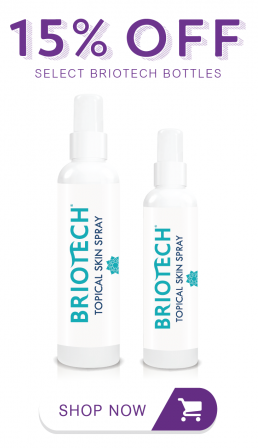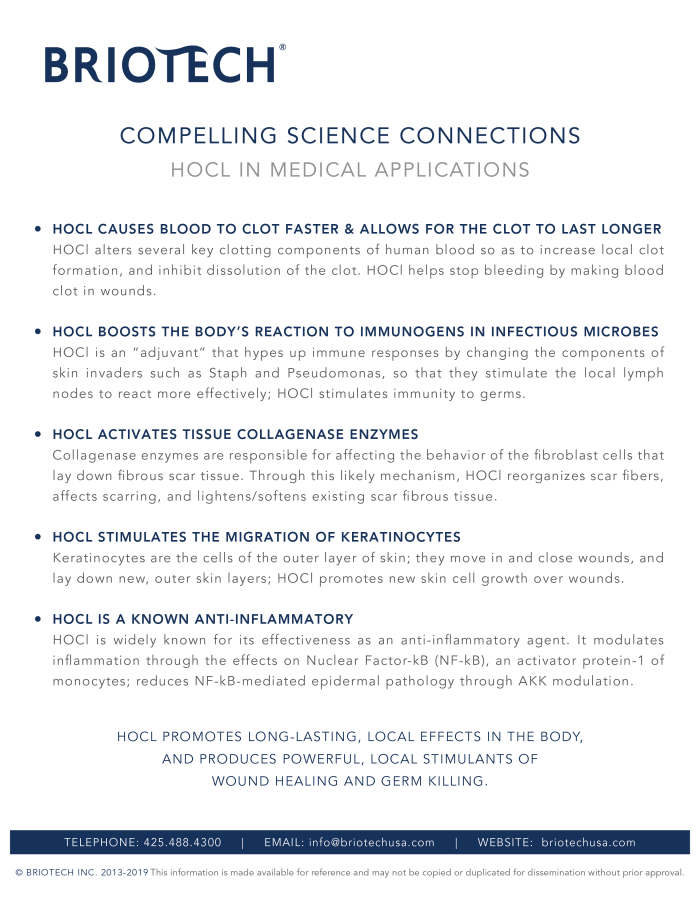CLICK TO BUY BRIOTECH SKIN SPRAY (and other products) 15% OFF
(Use discount code ANGEL at checkout.)
International shipping is available to many countries. Just follow the ordering process.
Or, you can order from Amazon.
Briotech is different from other aftercare products that have commonly been used in the body art industry. For one thing, substantial evidence-based scientific research backs up assertions about the active ingredient’s safety and effectiveness for wound healing. (See photos of my own lightning-quick wound healing with Briotech.)
It is incredibly easy to use: simply spray on a light mist 3-5x daily; that's it! Be sure to gently shake the bottle before use. (See all aftercare hints and tips here.)
Briotech’s active ingredient is hypochlorous acid (HOCl), a broad-spectrum antimicrobial that is actually produced by the body as part of the normal response to injury[i]. Briotech works by replicating and supporting this natural immune function. HOCl kills bacteria[ii] (including antibiotic resistant strains like MRSA and VRE), viruses, and fungi, without harming delicate healing tissue[iii]. It even deactivates spores in just 30 seconds! (We use spores to test autoclave sterilizers because they're so hardy!)
A remarkable advantage of hypochlorous acid (at the proper concentration and pH) is that it is totally benign, non-irritating, non-sensitizing, and non-cytoxic[iv], unlike many other cleaning products.
The inactive ingredients in Briotech are simply 99.08% electrolyzed water, and .9% NaCl (sodium chloride—isotonic saline), making it environmentally friendly, vegan, natural, hypoallergenic, and free of fragrances, oils, parabens, sulfates, and other irritants.
According to studies, HOCl helps blood to clot in wounds[v], so it can be used right after procedures. It increases immunity to microbes and produces powerful local stimulants of wound healing and germ killing[vi]. It even penetrates biofilm and kills microorganisms within biofilm[vii]. One study described stabilized hypochlorous acid as “…an ideal wound care solution with a powerful and rapid killing effect on different types of microorganisms”[viii] (emphasis added).
Natural HOCl production involves salt from the body and enzymes within the cells. Outside the body, by using a controlled application of electrical energy, the process can be mimicked. With Electro-Chemical Activated (ECA) technology, Briotech’s scientists engineered a means to mass-produce stable HOCl. Through this proprietary electrolyzing process, Briotech can maintain its effectiveness for up to two years. It is made in an FDA-registered manufacturing facility using current good manufacturing practices (cGMP) guidelines.
This is not a new product, but rather a different application for one that has been widely used for pathogen control in food service, hospitality, janitorial, agricultural, and medical settings. Hypochlorous acid is common for disinfection and sanitation of water, surfaces, tools, and equipment. Copious quantities of scientific studies document its safety and effectiveness for these purposes.
I've been suggesting it for years now, and the feedback from my clients has been truly fabulous.
Many of my respected colleagues, have been using it with great results. Fellow APP member, Bink Williams[ix], is a Registered Nurse and has been a professional piercer for over twenty years. He also participated in the development of body art legislation for his home state of Florida. He has been advocating Briotech for aftercare for a number of years. Like me, he is beyond impressed with its effectiveness. He’s convinced that this product is nothing short of miraculous at minimizing inflammation, accelerating healing, and increasing comfort[x]. He also notes that clients who’ve had multiple failed attempts with certain piercings have finally been able to heal successfully with Briotech as the only altered factor.
Briotech is simple to use: shake the bottle gently and spray on the light mist. It requires no rinsing and leaves no residue. The manufacturer explains the science in layman’s terms, and states that the spray is safe to use "repeatedly throughout the day.” Briotech’s versatility is evident and testimonials tout excellent results with “sun care, acne treatment, a wrinkle remedy, and scar reduction.”
To use:
Apply Briotech 3-5 times daily. That's it!
Simply shake the bottle gently, spray on the mist, and air dry, or pat dry with clean, disposable paper products. (No need to rinse.)
I am totally wowed by this product and find muliple uses for it every day, and I have used it on my own healing piercings and tattoos. I also had occasion to use it following a pretty serious gym accident that resulted in stitches. See photos of my lightning-quick wound healing with Briotech.
I put it on my toothbrush to keep it clean and support oral health, and apply it as hand sanitizer since it kills way more pathogens and does it far more quickly than soap and water or gelled alcohol. I apply it to mosquito bites, cuts, scrapes, burns, and stings, and use it after shaving or other depilation to soothe irritation. I put it on my face, in my eyes, and inhale it through my nose and mouth into my lungs! I also use it on my pets. Briotech is fantastic to have around!
Some newer articles:
"Topical stabilized hypochlorous acid: The future gold standard for wound care and scar management in dermatologic and plastic surgery procedures," Journal of Cosmetic Dermatology, February, 2020: https://pubmed.ncbi.nlm.nih.gov/31904191/
"Status Report on Topical Hypochlorous Acid: Clinical Relevance of Specific Formulations, Potential Modes of Action, and Study Outcomes," Journal of Clinical and Aesthetic Dermatology, November, 2018:
https://www.ncbi.nlm.nih.gov/pmc/articles/PMC6303114/
"Optimizing Wound Healing for Cosmetic and Medical Dermatologic Procedures," Practical Dermatology, March 2018:
https://practicaldermatology.com/articles/2018-mar/optimizing-wound-healing-for-cosmetic-and-medical-dermatologic-procedures/pdf
"The Role of Hypochlorous Acid in Managing Wounds: Reduction in Antibiotic Usage," Wound Source, March 2018: https://www.woundsource.com/print/blog/role-hypochlorous-acid-in-managing-wounds-reduction-in-antibiotic-usage
"Hypochlorous acid gel technology-Its impact on post-procedure treatment and scar prevention," Journal of Cosmetic Dermatology, June 2017: https://pubmed.ncbi.nlm.nih.gov/28370943/
[i]
“Hypochlorous Acid - Analytical Methods and Antimicrobial Activity” http://www.bioline.org.br/pdf?pr13020
[ii]
“Hypochlorous Acid: Its Multiple Uses for Wound Care” http://www.o-wm.com/article/pearls-practice-hypochlorous-acid-its-multiple-uses-wound-care
[iii]
“Hypochlorous Acid as a Potential Wound Care Agent” http://www.ncbi.nlm.nih.gov/pmc/articles/PMC1853323/
[vii]
“Treating Chronic Wounds with Hypochlorous Acid Disrupts Biofilm” http://www.todayswoundclinic.com/articles/treating-chronic-wounds-hypochlorous-acid-disrupts-biofilm
[viii]
“Hypochlous Acid: an ideal wound care agent with powerful microbicidal, antibiofilm, and wound healing potency.” http://www.ncbi.nlm.nih.gov/pubmed/25785777
[x]
This study documents pain relief with hypochlorous acid on wounds: http://www.iiste.org/Journals/index.php/JEP/article/viewFile/13072/13653
This Public Library of Science (PLOS) Pathogens article confirms that a specific Briotech HOCl patent-pending formulation (different from the skin spray) deactivates prions (the mis-folded proteins that cause Mad Cow and Creutzfeldt-Jakob Disease. It also includes information on the stability of Briotech--as HOCl was notoriously unstable prior to their innovation: http://journals.plos.org/plospathogens/article?id=10.1371/journal.ppat.1005914
2017 - The use of Briotech for infection control in the age of antibiotic resistance: https://infectioncontrol.tips/2017/10/06/hypochlorous-innate-response/
2017 - Using Briotech for wound decontamination and disinfection techniques in disaster response and management of displaced populations https://ieeexplore.ieee.org/document/8239259/


